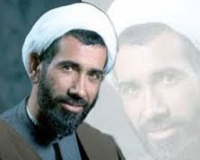Mohammad Javad Bahonar was born in Kerman, 1933. His education was entrusted to an old style school when he was at the age of five. After completing primary school, he received religious teachings in Massuoumieh School, and started acquiring modern educations at the same time. In order to...
Mohammad Javad Bahonar was born in Kerman, 1933. His education was entrusted to an old style school when he was at the age of five. After completing primary school, he received religious teachings in Massuoumieh School, and started acquiring modern educations at the same time. In order to follow his religious education, he left for Qom Seminary in 1953 and residing in the school, enjoyed the presence of Shiiate great teachers like Ayatollah Soltani, Ayatollah Mujahidi, Ayatollah Boroujerdi, Allameh Tabatabaei and Ayatollah Khomeini. Three years after arriving in Qom Seminary, he received his diploma degree, and participated in the entrance exam of the university and succeeded to enter the faculty of Theology. Bahonarreceived his BA degree, and followed his master’s degree in educational affairs.Then he received a doctorate of theology. From 1957 he began his journalistic activities and published the journal of “the Shia school”.
Due to political activities, he was repeatedly arrested and imprisoned by the Pahlavi regime during 1958-1963. Upon the rise of the clergy movement led by Imam Khomeini and the need for the active presence of militant clerics in social fields, Bahonar entered the scene and was among the influential figures in the cultural arena, and the positive impact of his actions in the Islamic movement was visible. Cooperation with the Islamic Coalition groups (Heiate Mo’talefe) and Refah institute.
In 1963, he was employed in the ministry of education. Further, he cooperated with the publication and Planning bureau of the ministry. The schedule of religious teachings was prepared under his advice and supervision. He had significant role in the awakening of the young adults and the youth before revolution. With his speeches in mosques, mourning halls, Bahonar communicated the thoughts and messages of Imam Khomeini, the movement plans and paved the ground for the ideological preparations of the Iranians to fight against Pahlavi regime.
Subsequent to his remarks about the celebrations of 2500 Iran’s imperial rule in 1971, he was summoned by the secret police and was prohibited to give speech in the pulpits. During this period, he embarked on some cultural activities including the foundation of center for publishing Islamic culture, Mofid secondary school, and establishment of Towhid center and Center for AmiralMomenin.
In 1977, demonstrations and opposition protests against the Pahlavi regime were accelerated. Along with other committed clerics, Bahonar added to his efforts to expose the real face of the regime. His lecture in Shiraz led to his arrest. Formation of militant clergies’ association, organization of protests and strikes were among his actions in that period.
For the purpose of organizing the revolution, and guiding the revolutionary groups, Imam Khomeini ordered for the formation of Islamic Revolutionary Council. Ayatollah Motahhari, Ayatollah Beheshti, Ayatollah Bahonar, and Ayatollah MussaviArdebili, and Aytollah Hashemi Rafsanjani were introduced as the main members of the council by Imam Khomeini. The council was formed in January 1958, and played an important role in leading and planning for the revolutionary affairs. The main goal of its foundation was safeguarding the fruits of the struggles of the freedom-loving Iranians, executing the goals of the revolution, formation of new political institutes, and formation of Islamic republic in Iran.
At a news conference, Bahonar gave a full report of the Council's functions and activities. Council members acted as loops to link the three branches with the revolutionary Council.
Seyyed Mohammad Hossein Beheshti and Mohammad Javad Bahonar, along with a group of other characters were attempting to establish the Islamic Republic party in 1978. Bahonar had a leading role in the party. After the martyrdom of Ayatollah Beheshti, he was appointed party general secretary and held this responsibility until he was appointed prime minister.
Upon the dismissal of Bani-Sadr from the presidency and election of Rajai as Iranian President, Bahonar was introduced to the majlis as prime minister in 1981. The life of his cabinet was short, as the president’s office was exploded in a terrorist attack and late Bahonar, president Rajai and some other political figures were martyred. Their bodies were buried in Behesht e Zahra cemetery in the presence of huge crowd of people.
Late Bahonar was an active, patient and honest man, having writing gift. His valuable books include Educational Discourses, Culture of Islamic Revolution, Manand Self-training and the World in the Era of Appointment. He never left his causes during his tumultuous life and never missed time to perform his religious mission and convey the Islamic thought.
https://iichs.ir/vdch.6nzt23n-w10d2.html
iichs.ir/vdch.6nzt23n-w10d2.html
